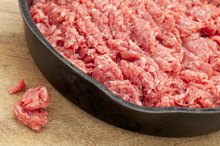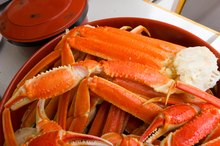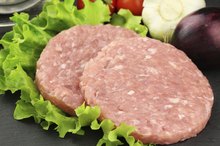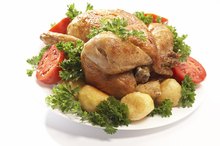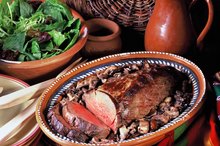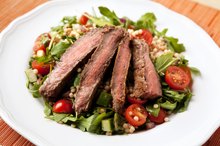What does fact checked mean?
At Healthfully, we strive to deliver objective content that is accurate and up-to-date. Our team periodically reviews articles in order to ensure content quality. The sources cited below consist of evidence from peer-reviewed journals, prominent medical organizations, academic associations, and government data.
The information contained on this site is for informational purposes only, and should not be used as a substitute for the advice of a professional health care provider. Please check with the appropriate physician regarding health questions and concerns. Although we strive to deliver accurate and up-to-date information, no guarantee to that effect is made.
How Much Cholesterol Is in Steak?
Although fat in the diet is important for your health -- it helps provide energy and absorb important fat-soluble nutrients -- you need to monitor how much cholesterol you eat. Steak is a source of cholesterol, but the grade of the meat,farming method, cooking style and cut all can affect cholesterol content.
Cut and Cholesterol
Beef steaks come from different parts of the animal, which affects fat and cholesterol content. Rib steaks, as the name indicates, come from meat attached to the ribs. Flank steak is from meat on the animal’s side, closer to the belly and hindquarters. Round steak comes from the rump. Rib steak, however, has more; 3 ounces of raw rib steak contains 60 milligrams of cholesterol.
- Beef steaks come from different parts of the animal, which affects fat and cholesterol content.
Grade and Cholesterol
Buffalo Meat Versus Beef Nutrition
Learn More
Grade also affects fat and cholesterol content. Grading takes into account characteristics such as texture, firmness, color and the amount of marbling, which is the fat interspersed with the lean meat. Texas A&M University notes that select beef, for example, has only slight marbling, while choice beef has moderate marbling 4. The USDA states that 3 ounces of select broiled ribeye steak contains 65 milligrams of cholesterol, while 3 ounces of choice broiled ribeye steak contains 68 milligrams of cholesterol.
- Grade also affects fat and cholesterol content.
- Texas A&M University notes that select beef, for example, has only slight marbling, while choice beef has moderate marbling 4.
Cooking Methods
Cooking methods can have some effect on cholesterol in a steak. Methods that allow fat to drain during cooking -- such as grilling or broiling -- can result in a lower fat and cholesterol content. Braising -- a cooking method in which the meat's cooked in liquid -- can also change the cholesterol content of a steak. The USDA reports 3 ounces of braised choice beef flank steak has 61 milligrams of cholesterol. Three ounces of broiled choice beef flank steak contains 69 milligrams of cholesterol.
- Cooking methods can have some effect on cholesterol in a steak.
- Braising -- a cooking method in which the meat's cooked in liquid -- can also change the cholesterol content of a steak.
Grass-Fed Beef
Low-Cholesterol Meat & Fish
Learn More
The conventional method of finishing beef is to feed cattle grain for several months to increase the amount of fat and marbling in the meat. Grass-fed beef, however, is raised without grain, which can affect cholesterol content. The USDA notes that 3 ounces of raw, grass-fed ribeye steak contains 42 milligrams of cholesterol, and 3 ounces of raw, grass-fed bottom round steak contains 47 milligrams of cholesterol. Similar amounts of conventionally raised ribeye steak and bottom round steak are higher in cholesterol.
- The conventional method of finishing beef is to feed cattle grain for several months to increase the amount of fat and marbling in the meat.
- Similar amounts of conventionally raised ribeye steak and bottom round steak are higher in cholesterol.
Cholesterol and You
If you're concerned about the amount of cholesterol in your diet or your physician has recommended you decrease your cholesterol intake, you can make different dietary choices. For example, select cuts tend to be lower in cholesterol, as does grass-fed beef. Cooking methods such as braising can also decrease total cholesterol content. You could also eat steak less frequently or in smaller amounts. Make sure your diet is otherwise healthy, with a wide variety of foods, such as:
- fruits
- vegetables
- legumes
- whole grains
- If you're concerned about the amount of cholesterol in your diet or your physician has recommended you decrease your cholesterol intake, you can make different dietary choices.
- Make sure your diet is otherwise healthy, with a wide variety of foods, such as: * fruits
* vegetables
* legumes
* whole grains
Related Articles
References
- The Harvard Medical School Family Health Guide: The Truth about Fats - Bad and Good
- United States Department of Food and Agriculture: Basic Report 23063, Beef, Round, Outside Round, Bottom Round, Steak, Separable Lean and Fat, Trimmed to 0" Fat, All Grades, Raw
- United States Department of Food and Agriculture: Basic Report 23179, Beef, Rib Eye Steak, Boneless, Lip Off, Separable Lean Only, Trimmed to 0" Fat, Select, Raw
- Texas A&M University: USDA Beef Quality and Yield Grades
- United States Department of Food and Agriculture: Basic Report 23148, Beef, Rib Eye Steak, Boneless, Lip-On, Separable Lean Only, Trimmed to 1/8" Fat, Choice, Cooked, Grilled
- United States Department of Food and Agriculture: Basic Report 23149, Beef, Rib Eye Steak, Boneless, Lip-On, Separable Lean Only, Trimmed to 1/8" Fat, Select, Cooked, Grilled
- United States Department of Food and Agriculture: Basic Report 13067, Beef, Flank, Steak, Separable Lean and Fat, Trimmed to 0" Fat, Choice, Cooked, Broiled
- United States Department of Food and Agriculture: Basic Report 13066, Beef, Flank, Steak, Separable Lean and Fat, Trimmed to 0" Fat, Choice, Cooked, Braised
- United States Department of Food and Agriculture: Basic Report 13949, Beef, Flank, Steak, Separable Lean and Fat, Trimmed to 0" Fat, Select, Cooked, Broiled
- Beef, loin, tenderloin steak, boneless, separable lean only, trimmed to 0" fat, choice, cooked, grilled. FoodData Central. U.S. Department of Agriculture. Published April 1, 2019.
- Daley CA, Abbott A, Doyle PS, Nader GA, Larson S. A review of fatty acid profiles and antioxidant content in grass-fed and grain-fed beef. Nutr J. 2010;9:10. doi:10.1186/1475-2891-9-10
- Bradlee ML, Mustafa J, Singer MR, Moore LL. High-protein foods and physical activity protect against age-related muscle loss and functional decline. J Gerontol A Biol Sci Med Sci. 2017;73(1):88-94. doi:10.1093/gerona/glx070
- How to keep your immune system healthy. Academy of Nutrition and Dietetics. Updated 2018.
- Avoiding anemia boost your red blood cells. NIH News in Health. Updated 2014.
- Micha R, Michas G, Mozaffarian D. Unprocessed red and processed meats and risk of coronary artery disease and type 2 diabetes--an updated review of the evidence. Curr Atheroscler Rep. 2012;14(6):515-24. doi:10.1007/s11883-012-0282-8
- Pisazka V, Duscher G, Hodžić A, Reider N, Allerberger F. Alpha-gal allergy after a tick bite in Austria. Wien Klin Wochenschr. 2019;131(15-16):385-388. doi:10.1007/s00508-019-1506-5
- Saturated fat. American Heart Association. Updated 2020.
- Meadows L. What's your beef - prime, choice or select?. U.S. Department of Agriculture. Updated 2019.
- Nyquist KM, O'quinn TG, Drey LN, et al. Palatability of beef chuck, loin, and round muscles from three USDA quality grades. J Anim Sci. 2018;96(10):4276-4292. doi:10.1093/jas/sky305
- A fresh look at beef. Berkeley Wellness University of California. Updated 2016.
- Food safety risks for pregnant women. Academy of Nutrition and Dietetics. Updated 2018.
Writer Bio
Beth Greenwood is an RN and has been a writer since 2010. She specializes in medical and health topics, as well as career articles about health care professions. Greenwood holds an Associate of Science in nursing from Shasta College.
